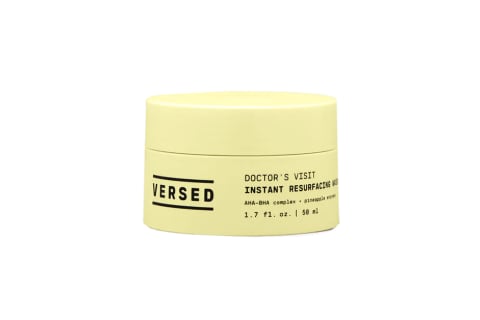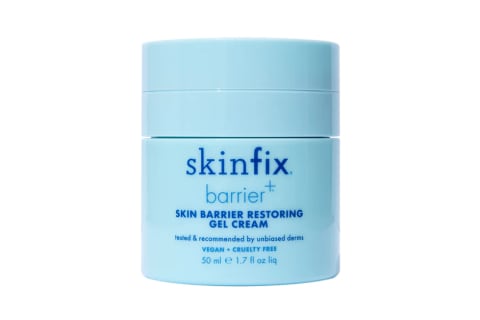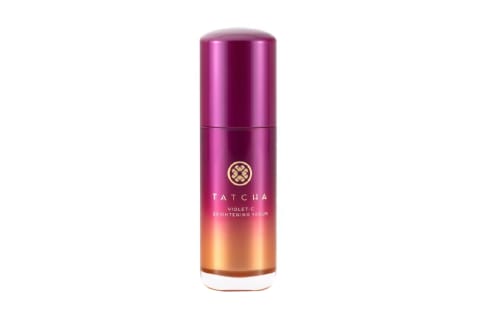Textured Skin 101: Causes, Treatments, Prevention + More Tips From Derms

Let's be clear: Nobody has perfectly smooth skin all the time. While heaps of makeup and hours of photo editing may have you believing skin should look like silk, that's not normal. Everyone has texture, and there are plenty of reasons for it.
However, having textured skin from things like acne scars or skin conditions can make you feel extremely insecure and directly impact your mood. So, it's only natural that you may want to ease texture when possible. To help you out, we asked derms for their best tips and tricks. Plus, a bit more about why your skin might be textured in the first place.
Causes of textured skin.
There are countless reasons your skin has texture, and some are more severe than others. What's more, some forms of texture occur as a secondary result of underlying skin conditions and thus may serve as a helpful tool in diagnosing any relevant skin diseases like acne, eczema, etc.
Acne scars:
One of the more common forms of texture is acne scars—but there's more than just one kind of mark. We've taken a deep dive into acne scars before, so here's an overview of the different types for a bit more context:
- Ice pick: Ice pick scars are a form of atrophic scar, which means it's indented rather than raised. (Research shows that 80 to 90% of people1 with acne scars have indented.) These look like small, narrow pinholes in the skin, with steep fall-offs. They are called "ice pick" scars because they look like an ice pick was used on the skin.
- Boxcar scars: Another form of atrophic scarring, boxcars look like small oval, circular, rectangular, or square pits. They often have steep drop-offs into a U-shaped scar. These are unlike ice pick scars in that they are wider and don't usually go deep into the dermis.
- Rolling scars: These scars are characterized by wavelike, undulating skin. These are the result of long-term, chronic acne—as the repeated inflammation and trauma to the skin creates uneven scar tissue. In many cases, the appearance is shallow and perhaps not very noticeable.
- Hyperpigmentation: These are surface-level stains where the pigment of the skin is altered due to inflammation2—essentially when skin is inflamed, it can trigger or halt pigment production. Hyperpigmentation on pale skin tones often appears red or pink, while darker skin tones usually appear brown or black. Hyperpigmentation isn't technically a scar, but it can cause localized uneven texture.
Rosacea & eczema:
While redness is the most common symptom of rosacea, it's not the only one. According to the American Academy of Dermatology, rosacea symptoms can also include roughness, small bumps, and even thickening skin that can lead to more uneven texture (though the latter is rare).
Eczema (also known as atopic dermatitis) can also cause uneven skin texture. This can look like scaly, dry patches or thicker skin.
Plus, both skin conditions can cause excessive dryness on the skin, which is another form of texture. When treating texture from rosacea or eczema, you should consult your dermatologist. Many of the over-the-counter methods that are marketed for smoothing texture might irritate these highly sensitive skin types.
Collagen loss.
Orange peel skin is one form of texture that is, in part, related to collagen loss. Imagine a citrus peel—the texture isn't necessarily smooth, but it's not dramatically uneven either. To the naked eye, the skin looks dimply and has enlarged pores.
"It's a sign of sun damage and aging. Basically, as collagen and elastin are compromised, the pores are not held closed, leaving them larger and more visible," Morgan Rabach, M.D., board-certified dermatologist and co-founder of LM Medical NYC previously said about orange peel skin.
Everyone experiences a dip in collagen production as you age—at a rate of 1% each year3 after you hit your mid-20s. Given the decline, you may experience more skin texture with age. There's an easy remedy for this one—more on that to come.
Solutions for textured skin.
Now that you're familiar with the basic causes of skin texture, let's dive into the best remedies:
AHAs
"AHAs work to improve skin by removing the top layers of the skin through weakening the lipids that bond them together, thus removing dull and dead skin cells and revealing healthy skin cells," says board-certified dermatologist Dendy Engelman, M.D.
The most popular of the AHA family are glycolic acid and lactic acid. "Glycolic acid, derived from sugar cane, is the smallest acid in size, meaning the molecule can get deep into the skin," says Engelman.
This makes it a go-to for breaking down and removing dead skin cells and particles. It also boosts collagen and elastin production. As for lactic acid, Engelman says it's a good option for those with sensitive skin. It's derived from sour milk and works to improve discoloration and age spots.
Retinol
"Retinoids are particularly helpful as they help to improve cell turnover, stimulate collagen, and regulate sebaceous glands," board-certified dermatologist Rebecca Marcus, M.D., FAAD, explains.
However, retinol won't work instantaneously. You'll have to commit to using the product every few days for a good month or two before seeing peak smoothing results. "With continued usage of this ingredient and over time, you can see an improvement in fine lines, wrinkles, tone, and texture, as it is strengthening the skin barrier," Engleman says.
Now, there's more than one kind of retinol to consider—so read up on the differences between over-the-counter forms and prescription-grade products here.
Vitamin C
Using vitamin C topically has been shown to help overall quality and tone by diminishing hyperpigmentation4, brightening5 complexions, decreasing moisture6 loss, helping reduce skin inflammation4, and fighting against UV-induced photodamage7.
In fact, vitamin C can help almost any skin issue you can think of, from dark spots and discoloration to combating rosacea4 and acne4 to wrinkles and sagging. This makes vitamin C a great addition to your skin care routine, even while you're using other methods to ease texture.
Anti-inflammatory topicals
As mentioned above, skin texture can be caused by inflammation. What triggers your inflammation is important to note (dehydration, rosacea, acne, etc.), but how you tame it is just as essential.
To mitigate inflammation on the skin, look to soothing topicals. A few of the best ingredients to keep an eye out for include:
- Turmeric
- Botanical oils
- Centella asiatica
- Hemp seed oil
- CBD
- Biotic ingredients like pre- and postbiotics
In-office treatments
If you're struggling to ease skin texture at home, you're not alone. Especially deeper scars (like ice-pick acne scars) are nearly impossible to treat DIY-style. While this might make you feel discouraged at first, you should find peace knowing that assistance is available (plus, some much-needed reassurance that you're probably doing all the right things).
There are a few different methods to treating textured skin in the office—here's a quick breakdown of some of the best.
- Fractional lasers: Clear and Brilliant, a specific type of fractional laser, "Works by creating millions of microscopic treatment zones in the upper layers of the dermis, replacing damaged skin with healthy tissue to yield refreshed, more even-toned skin. This treatment requires little to no downtime," medical esthetician and founder of JTAV Clinical Skin Care Joie Taverise tells mbg.
- Chemical peels: "These use safe and gentle acids to remove excess dead skin cells that make skin look dull tired and pigmented. The most common are glycolic, lactic, and salicylic acid-based peels. Removing the top layer of dead skin cells speeds up cell turnover and stimulates skin regeneration to give skin a healthy glow," Tavernise says.
- Vivace RF Microneedling: "This treatment combines targeted microneedling with radiofrequency (RF) to stimulate collagen and tighten skin. Tightened skin means that wrinkle texture and enlarged pores will appear smoother when skin elasticity is improved. Vivace is incredibly effective because microneedling allows the radio frequency to penetrate deeper into the skin to stimulate natural collagen production for real results," she explains.
Internal collagen support
Given that skin texture can be caused by a lack of collagen in the skin, it only makes sense that collagen supplementation can help. You should be mindful of what kind of collagen you purchase, as hydrolyzed collagen peptides have been the most extensively studied.
More specifically, research has shown that taking collagen peptides will support skin elasticity, hydration levels, and promote youthful texture8.* Not to mention, collagen can help support your gut health9, which is essential for easing inflammation from the inside out (yes your gut and skin are connected).
To ease your search, here's our curated list of the 9 best collagen supplements on the market, all backed by a nutrition Ph.D.
Plumping and hydrating ingredients
If your texture is caused by dry skin, or the texture of your skin creates sagging, then hyaluronic acid is a must-have in your lineup. Hyaluronic acid (HA) is a natural humectant, which means it retains moisture.
For HA, that's 1,000 times its weight in water. So, it's really hydrating. "It helps smooth the skin surface due to increasing the amount of water in the dead cell layer, which delivers moisture to dry, rough skin surface," Loretta Ciraldo, M.D., FAAD, tells mbg.
Consider this hydrating acid like a tall glass of water for your skin. You can choose to use it in the form of a serum (like one of these mbg-approved picks) or look for hyaluronic acid in your moisturizers and face creams.
Regular facials
Getting regular facials has a very long list of benefits, including maintaining a smooth complexion. Depending on what other skin concerns you have (dryness, acne, skin aging, etc.), what type of facial you get will differ.
See when you visit a skin expert like an esthetician, they can help clear your dead skin cells via gentle exfoliation to reveal a fresh new canvas. Plus, the high-tech tools and professional-grade topicals might help you clear your texture even more quickly.
If you want to learn more about the different types of facials and which ones might be the best for your skin, check out this guide.
Enzymes
"Enzymes work by ungluing stored-up dead cells at the skin surface and in the pores," Ciraldo says. "This could include bromelain from pineapple, pumpkin, or pomegranate." You can find enzymes in at-home products like masks and cleansers or opt for a professional enzyme facial.
These are particularly beneficial for those with eczema and rosacea, as classic exfoliants like AHAs and BHAs might be irritating for highly sensitive skin.
Best products for textured skin
How to prevent textured skin.
Prevention is always going to be easier than treatment. This means not just preventing texture from the start but also ensuring that what texture you do have doesn't get even worse.
Especially if you're putting time and effort into clearing your skin, you'll want to do basic maintenance as well. Here are a few tips to keep in mind:
- Wear sunscreen daily: Sun exposure is one of the leading causes of uneven skin texture. Here's why: When your skin is exposed to the sun without protection, the body's natural collagen production is compromised, and this can lead to a variety of texture issues with the skin. This can show up as tiny bumps, rough patches, oversize pores, and even dark spots that have a rough texture on the surface, aka hyperpigmentation. One study, focusing on Caucasian skin, found that UV exposure was responsible for 80% of visible facial aging signs10, including wrinkles, skin texture, pigmentation, and sagging of tissues.
- Tend to acne: Preventing acne from turning into scars is one of the best ways to mitigate texture. This starts with basic acne care. You'll want to determine what kind of breakouts you have and then consult a dermatologist for the best treatment options. Most importantly, don't ever pop your pimples. This will increase the likelihood of scaring and thus uneven texture. Not sure where to start? Here's our acne breakdown to help you out.
- Hydrate + calm inflammation: For your general skin care routine (disregarding retinol and exfoliants), focus on hydration and easing inflammation. See, if you have too many harsh ingredients in one routine, your skin will become irritated and inflamed, leading to more uneven texture. Do your best to place those powerful ingredients within a soothing routine, and don't mix harsh actives. You may consider the popular skin cycling method to make it easier—here's everything you need to know.
When to see a pro.
As you can tell, there are plenty of at-home options for easing skin texture. That being said, not everything is DIY-friendly. It can make you feel even worse if you're trying at-home remedies again and again with no success, so it's important to know when to ask for help if you have access to it.
Visiting a dermatologist can be immensely helpful for stubborn texture, like that of acne scars or even severe cases of rosacea that need to be treated with pro-grade treatments. Of course, trying at-home remedies first is a good idea, but visiting the experts might be just what your skin needs.
FAQ
Is it normal to have textured skin?
Yes! Skin texture is very normal, and everyone has it to some degree. Especially for those with inflammatory skin conditions like acne, eczema, and rosacea, skin texture is even more common.
How can I improve my skin texture naturally?
The best way to improve your skin texture at home is by using AHAs, retinol, vitamin C, and anti-inflammatory topicals. Remember to drink enough water and prioritize collagen intake as well.
Why is my face getting textured?
Skin texture can be caused by many factors including acne, rosacea, eczema, skin aging, and dryness, just to name a few.
The takeaway.
While airbrushed images may have you convinced skin texture is abnormal, the opposite is true. Texture is caused by a plethora of factors, from acne to dryness to aging and more. To ease texture at home, prioritize gentle exfoliation, retinol, topical hydration, and anti-inflammatory topicals. If you're struggling with skin texture after giving the at-home remedies a shot, it's best to visit a dermatologist. If you're struggling with texture in the form of bumps, this story may help you get some clarity on what's causing your unique texture.

Hannah Frye is the Assistant Beauty & Health Editor at mindbodygreen. She has a B.S. in journalism and a minor in women’s, gender, and queer studies from California Polytechnic State University, San Luis Obispo. Hannah has written across lifestyle sections including skin care, women’s health, mental health, sustainability, social media trends, and more. She previously interned for Almost 30, a top-rated health and wellness podcast. In her current role, Hannah reports on the latest beauty trends and innovations, women’s health research, brain health news, and plenty more.
10 Sources
- https://www.ncbi.nlm.nih.gov/pubmed/11423843/
- https://www.jaad.org/article/S0190-9622(17)30128-7/abstract
- https://www.ncbi.nlm.nih.gov/pmc/articles/PMC3583892/
- https://www.ncbi.nlm.nih.gov/pmc/articles/PMC3673383/
- https://www.ncbi.nlm.nih.gov/pmc/articles/PMC4562654/
- https://www.ncbi.nlm.nih.gov/pmc/articles/PMC5579659/
- https://www.ncbi.nlm.nih.gov/pubmed/22206077
- https://www.ncbi.nlm.nih.gov/pmc/articles/PMC4206255/
- https://www.ncbi.nlm.nih.gov/pubmed/14600124
- https://www.ncbi.nlm.nih.gov/pmc/articles/PMC3790843/



